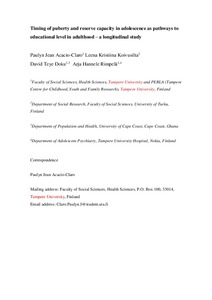Timing of puberty and reserve capacity in adolescence as pathways to educational level in adulthood – a longitudinal study
David Teye Doku; Paulyn Jean Acacio-Claro; Leena Kristiina Koivusilta; Arja Hannele Rimpelä
https://urn.fi/URN:NBN:fi-fe2021042824678
Tiivistelmä
Background. Family socioeconomic status (SES) is related to a child´s educational success. Intermediate pathways for this relationship, such as through pubertal timing and reserve capacity, occur in adolescence.
Aim. To study whether family SES affects a child’s adult education through a psychosocial and behavioural pathway (reserve capacity) and/or a biological pathway (pubertal timing) or only through school achievement in adolescence.
Subjects and methods. Finnish adolescents sampled in five cross-sectional surveys from 1985-1995 (N = 37,876) were followed through the Registry of Completed Education and Degrees until 2009, when they were 29-43 years old. Family SES data also came from this registry. Structural equation modelling adjusted for ages at baseline and follow-up was used.
Results. Low family SES increased the probability of low adult education, delayed pubertal timing (in boys), weak reserve capacity and low school achievement. Reserve capacity and school achievement directly affected adult education and mediated the relationship of family SES with the outcome. Delayed pubertal timing predicted low adult education except when school achievement was added to the model.
Conclusions. Our results show that family SES affects the child’s adult education level through psychosocial and biobehavioural pathways, but the biological pathway is mediated by school achievement.
Kokoelmat
- Rinnakkaistallenteet [19204]
